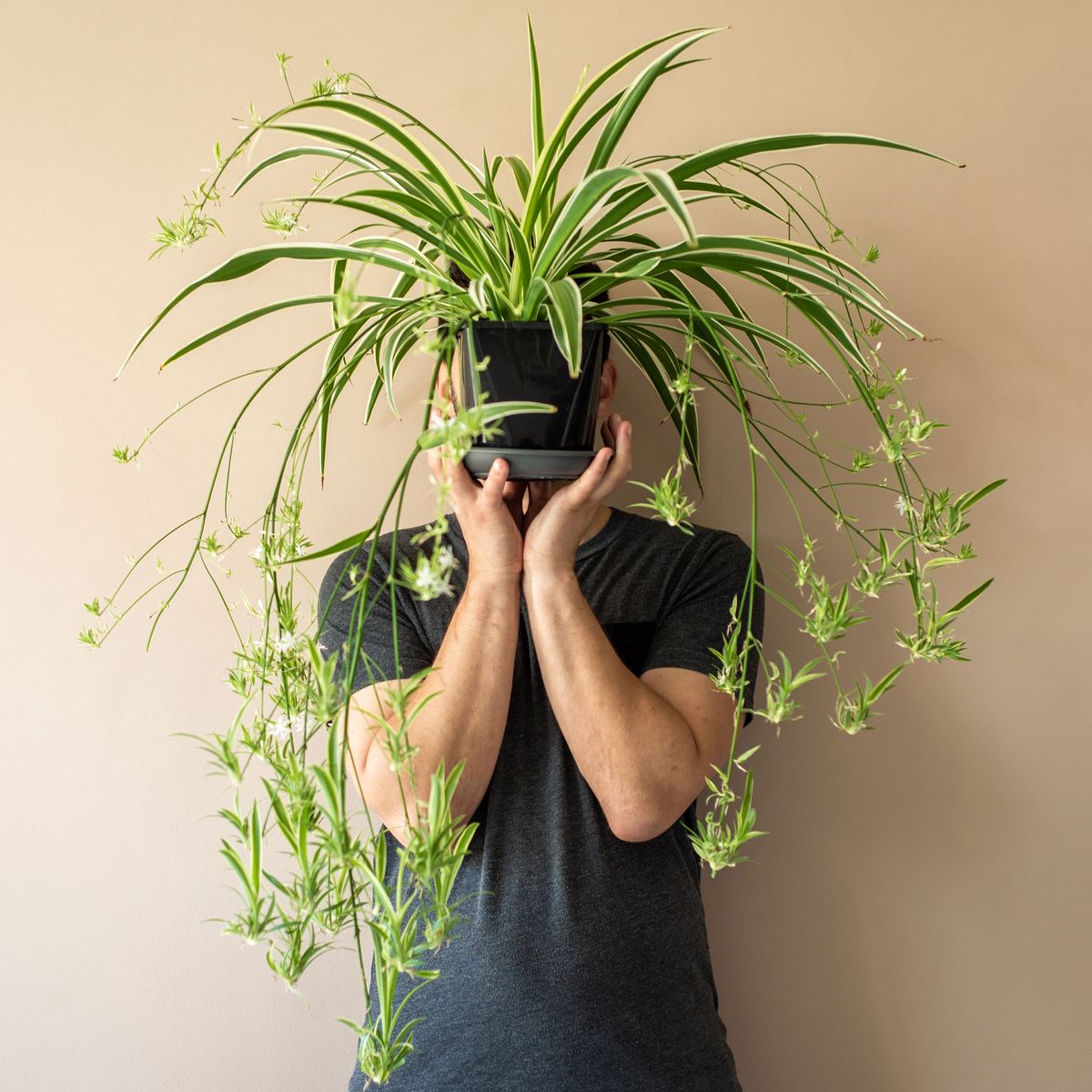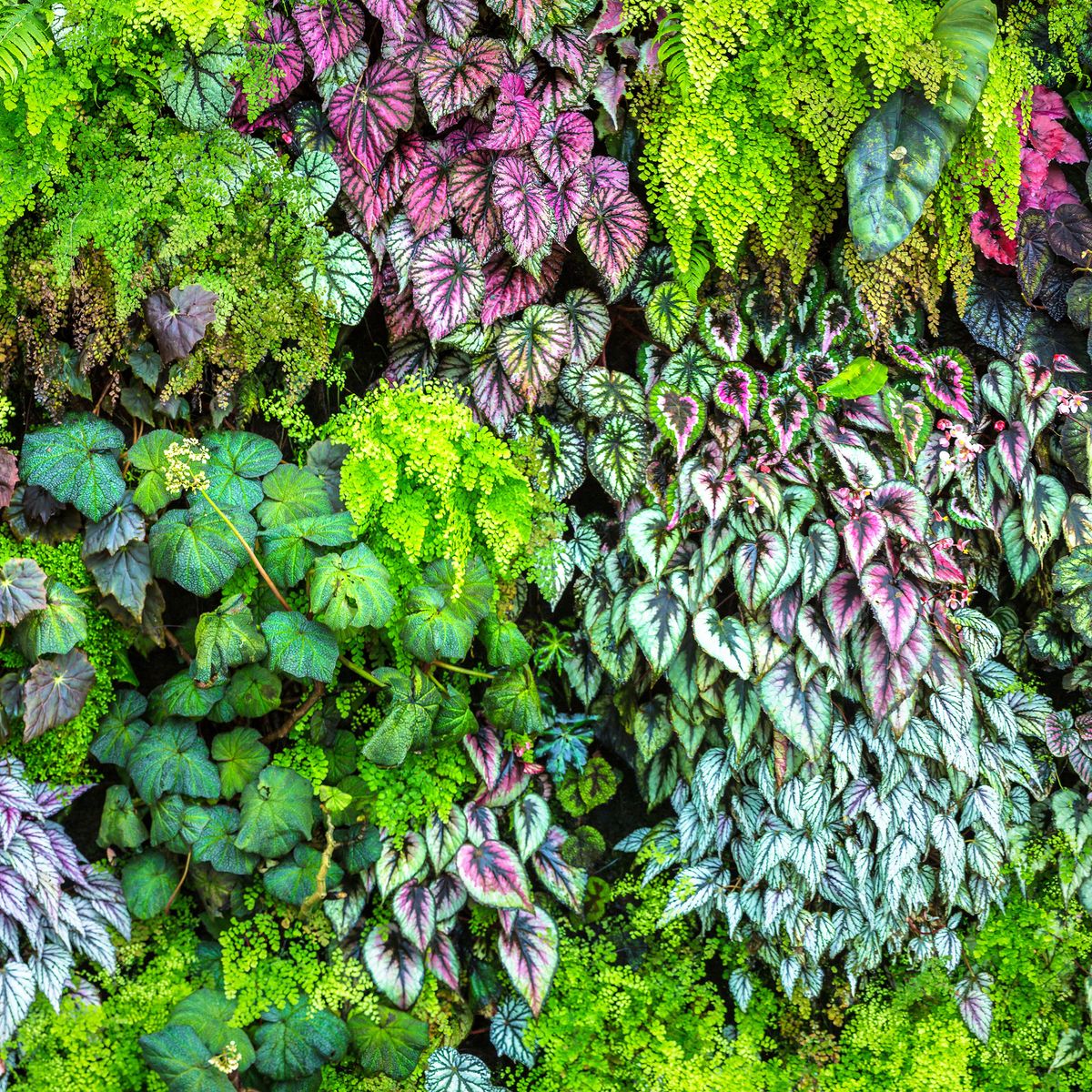2. Astilbe
When you mention shade-loving bloomers, you’re going to hear hostas, hellebores, and astilbe (Astilbe spp.). The fuzzy, vibrant spikes of flowers are just too incredible to pass up.
These plants can grow anywhere from one to six feet tall, depending on the species.
This perennial blooms from early to late summer, depending on the species, even in dense shade in Zones 3 to 9. They need hardly any attention to look their best, all while providing a colorful contrast to the summer green of camellias.
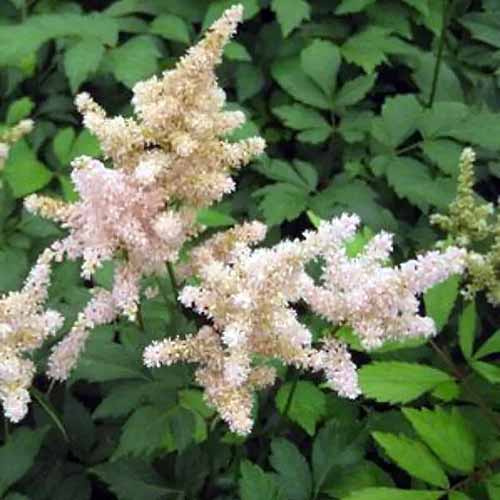
‘Peach Blossom’ Astilbe
I personally think that ‘Peach Blossom’ is a particularly pretty hybrid, with its large, peachy feather-like flowers. You can bring one home from Nature Hills Nursery in a #1 container.
Learn more about growing astilbe in our guide.
3. Aucuba
Aucuba (Aucuba spp.) are evergreen shrubs that grow six to 10 feet tall, with glossy leaves. They somewhat resemble laurels or camellias, and they like the same conditions, so the plants are often confused.

But aucuba don’t have the showy blossoms of camellias, though they do produce pretty red drupes. What makes them stand out, though, is the fascinating foliage.
The leaves can have cream or white splotches, spots, or other patterns of variegated color.
While the japonica species is the most popular, any in this genus has something to offer those who live in Zones 6 to 9.
Plant them near your camellias but far enough away that they’ll receive full sun.
4. Azalea
Azaleas (Rhododendron spp.) and camellias have very similar requirements but bloom at different times, so you can enjoy a colorful show for a larger portion of the year.
Camellias bloom anywhere from late fall to midspring, while azaleas are performing in the spring, summer, or early fall, depending on the cultivar.
Both plants like acidic soil with a pH somewhere near 5.5 and both tolerate semi-shade positions with around four hours of direct light per day.
They both need about the same amount of water, typically when the top inch or two of soil has dried out.
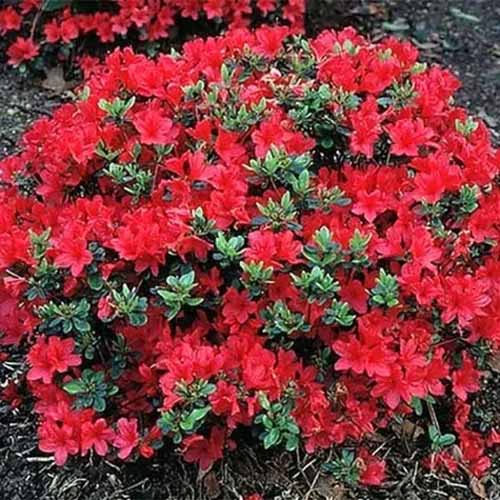
‘Hino Crimson’ Azalea
‘Hino Crimson’ is particularly floriferous and eye-catching with its bold red blossoms. It’s available at Nature Hills Nursery in #3 containers.
Azaleas grow in Zones 6 to 9, though there are a few that can tolerate life in Zone 5. The plants can range from a foot tall to over 20 feet tall, depending on the species or cultivar.
If you choose a smaller one, you can plant it under your camellia, while larger ones can be planted nearby with some afternoon shade.
Learn more about how to grow azaleas in our guide.
5. Begonia
Tuberous begonias (Begonia x tuberhybrida) are foot-tall winter bloomers that can add an additional punch of color underneath your camellias. They bloom at the same time and begonias will grow happily in the dappled shade of your shrubs.
If you’re in Zones 9 or 10, you can enjoy the pairing and kiss the winter blues goodbye. Begonias will even bloom a bit before and after most camellias are flowering, so they’ll keep the performance going.

‘Roseform Yellow’
What about something like ‘Roseform Yellow’ and its pretty yellow blossoms? You can find this option at Nature Hills.
You can find our guide to growing tuberous begonias here.
6. Bergenia
You have to be really careful when you pick a type of bergenia (Bergenia spp.) because most species grow in Zones 4 to 6 and others can grow up to Zone 9.
At 18 inches tall, they can grow under or next to your camellias in part to full shade.
If you want them to complement your camellia, you need to pick one that is compatible with your growing zone.
For instance, B. cordifolia ‘Winter Glow’ is good to go in Zones 3 to 8 and when the fuchsia-red flowers aren’t present, the bronze foliage will draw the eye.
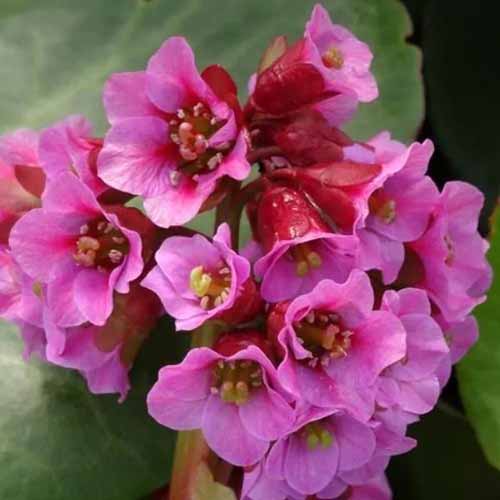
‘Winter Glow’ Bergenia
Sound good for your garden? You can bring one home from Nature Hills Nursery.
You can learn more about how to grow bergenia in our guide.
7. Bleeding Heart
Bleeding hearts (Lamprocapnos spectabilis and Dicentra spp.) are such delicate, subtle woodland plants.
I have some Pacific bleeding hearts (Dicentra formosa) under some of my camellias that I’ve pruned into a tree shape, and their sweet early spring blossoms never fail to make me smile.
Because they tolerate a good deal of shade, they can be planted under or next to your camellias where they will be protected from harsh sun.
I think they’re all the more special for how short their blooming season is. You can find bleeding hearts for Zones 3 to 9 in colors like pink, red, purple, and white in sizes up to four feet tall.

‘King of Hearts’ Bleeding Heart
Or how about something in both pink and purple with a hint of white? That’s what ‘King of Hearts’ has.
The blossoms form in tight clusters and last for a long time. Nab a bare root from Burpee.
Check out our guide to growing bleeding hearts to learn more.
8. Bugleweed
The great thing about bugleweed (Ajuga spp.) is that you’d be hard pressed to find a place where this mint relative won’t grow. If you need something tough and reliable with pretty purple flowers, this is one to pick.
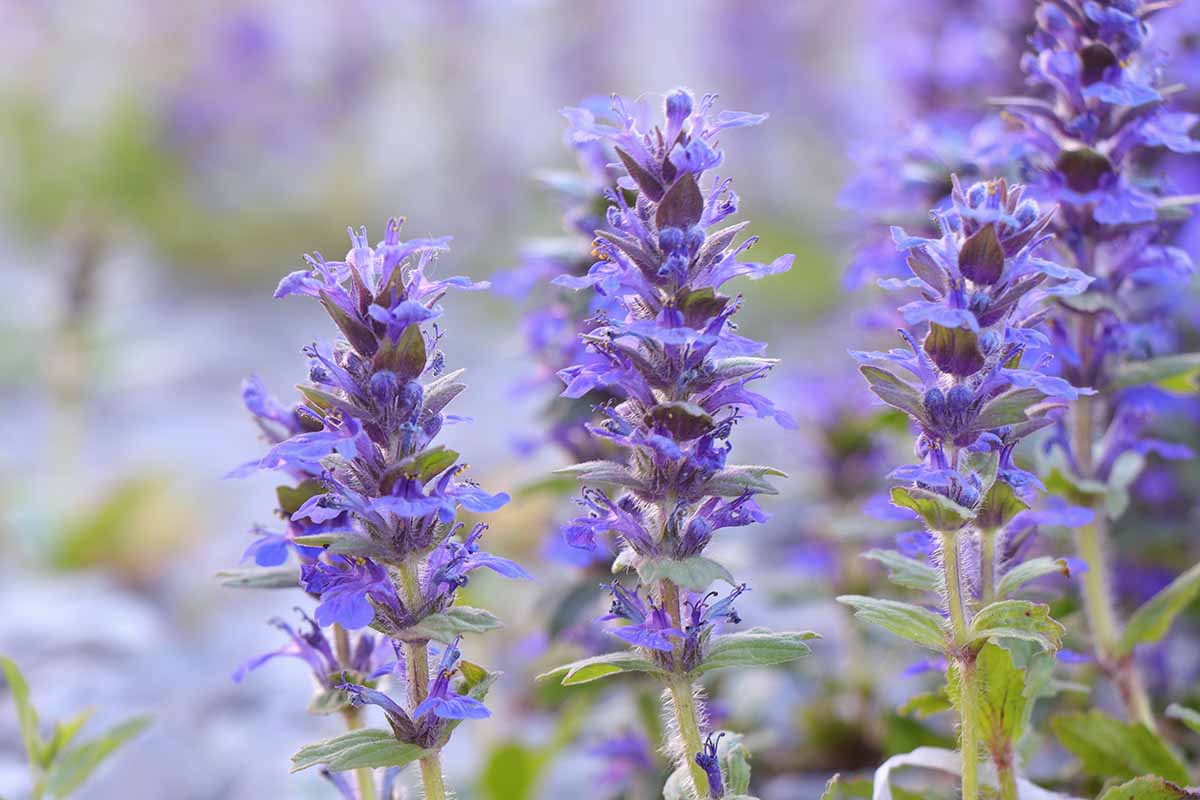
Just be aware that its gregarious nature can be a bit overbearing. It might want to spread into your lawn and other parts of your garden in Zones 4 to 9 if you aren’t careful.
Still, the pretty bronze-green leaves and purple flowers might just be a welcome addition wherever it creeps.
Because bugleweed only grows about six to nine inches tall, it’s perfect as a carpet on the south side of the camellia, since it needs partial sun. It will probably spread underneath the plant, but start on the south side and see where it wants to go.
Home Depot carries this enthusiastic plant in packs of six.
If you just don’t want to have to weed underneath your camellias anymore, you’ve found the answer.
9. Coral Bells
I can’t get enough of coral bells (Heuchera spp.). Like most plants primarily grown for their foliage, they tend to be overlooked for something that can put on a showier performance.
Don’t ignore these plants, though. The foliage can have such fascinating patterns that they might as well be flowers.
Most species grow in Zones 4 to 9, though you can find outliers, and they’re just as happy in full sun as full shade, depending on the cultivar.
I truly don’t know how they can be so adaptable. Plant them under or next to your shrubs, depending on your needs and the cultivar you choose.
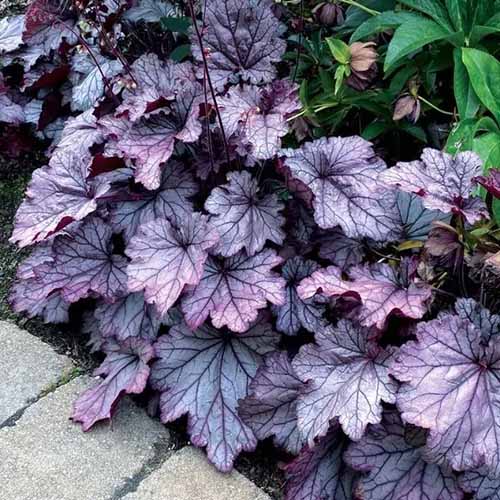
‘Spellbound’ Coral Bells
You’ll be spellbound by the rose purple, heavily ruffled leaves of ‘Spellbound.’ You can buy it at Nature Hills in a #1 container.
Learn more about growing heuchera in our comprehensive guide.
10. Crabapple
Let’s hear it for crabapples (Malus spp.). They put on a killer floral display in the spring, are much tougher than their apple cousins (and crabapples are also edible!), and they’ll happily grow paired up with camellias.
You can find petite options around seven feet tall that will act as a centerpiece to the shrubby frame when planted in front of a row of large camellias or go for a larger option to plant nearby.
Full-sized trees grow about 20 feet tall. Anyone in Zones 4 to 8 can enjoy these pretty trees.
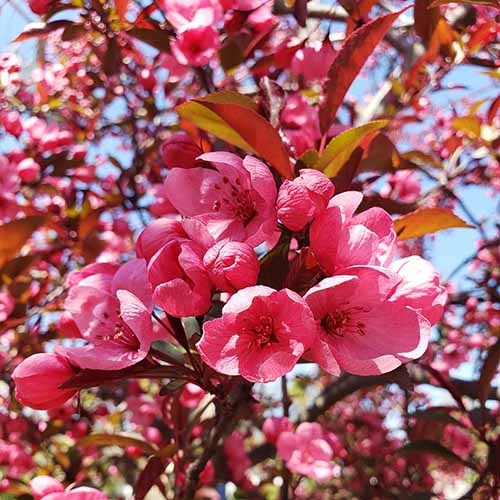
‘Show Time’ Crabapple
If you want a crab apple that puts on a seriously impressive performance, check out ‘Show Time.’
Available at Fast Growing Trees in a variety of sizes, it has huge, double blossoms in a gorgeous pink hue.
Learn more about growing crabapples in our guide.
11. Cyclamen
I hear what you’re saying, cyclamen (Cyclamen persicum) are only hardy in Zones 9 to 11. There’s only a tiny growing zone overlap with camellias.
While that’s true, cyclamen are fabulous as foliage annuals, or you can dig them up at the end of the growing season and grow them as houseplants.
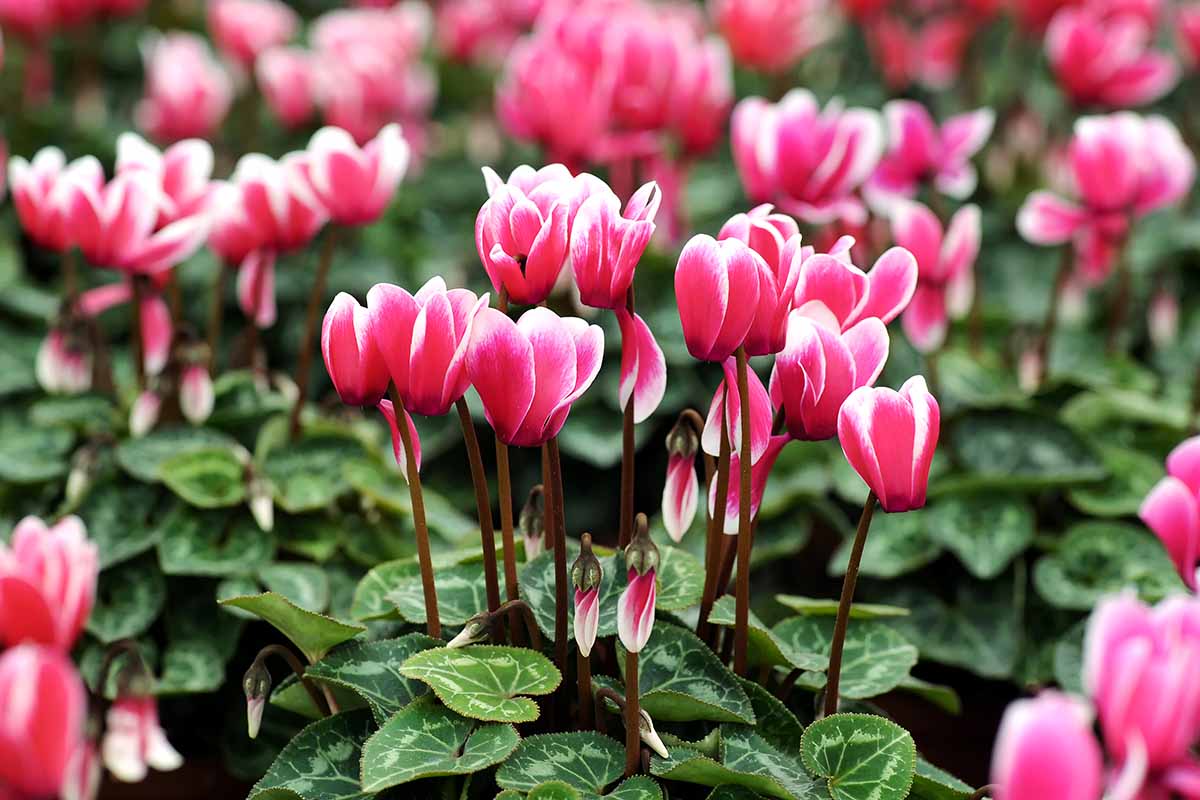
Those that can enjoy both will have a vibrant winter display, with cyclamen blooms covering the ground and camellias covering the vertical show.
Otherwise, let the striking foliage add a pleasing element to the area surrounding or underneath your camellia shrubs.
Since they only grow between six to 18 inches tall, they can serve as a colorful carpet or a side addition in a shady area.
Bring home a five pack of bulbs with silver and green variegated foliage and purple-pink blossoms from Home Depot.
12. Daffodil
If you want some bright color underneath a tree-shaped camellia, you can’t go wrong with daffodils. Imagine some frilly ‘Erlicheer’ blooming at the same time as your camellias.
‘Erlicheer’ has fragrant, white and cream flowers that grow up to 16 inches tall and can be had in packs of ten, 20, 50, 100, 500, or 1,000 at Dutch Grown.

‘Erlicheer’ Daffodils
Or, if you want a more classic display that will last for months, grab Dutch Grown’s Eight Weeks of Daffodils pack, which contains a mix of cultivars that take turns blooming, with early, mid, and late flowering types.

Eight Weeks of Daffodils
It’s available in quantities of 50, 100, 500, 1,000, or 5,000 bulbs.
One of the big differences between the growing requirements of daffodils and camellias is that daffodils really must have full sun to bloom beautifully, though you might get away with a tiny bit of shade. For that reason, they’re best kept on the south side of your shrubs.
Otherwise, they do well with the same water and pH needs as camellias, and they grow in Zones 3 to 8.
You can learn more about growing daffodils in our guide.
13. Deutzia
I’m so happy that deutzia (Deutzia spp.) is finally gaining some attention from home gardeners.
These plants have such marvelous white or pink blossoms in the early spring, covering them so densely that you can hardly see the foliage.
And speaking of foliage, it turns chartreuse or gold in the fall, adding yet another layer of interest when your camellias are in their summer cloak.
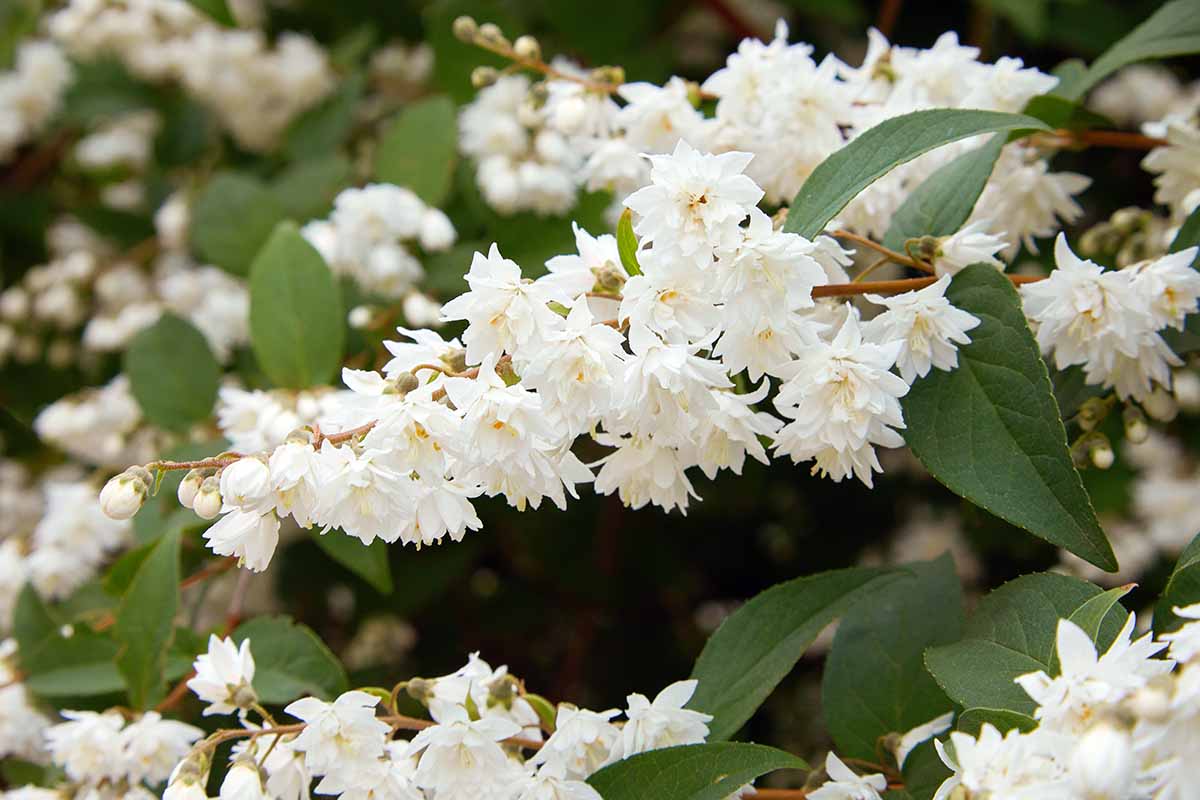
Deutzia grows in Zones 5 to 8 and need full sun to look their best, so don’t let your camellia plants shade them.
Plant them nearby on the east, west, or south side – but avoid the north side. Depending on the species, they can grow from one to 10 feet tall.
Visit Home Depot to pick up a live plant with cherry pink blossoms in a four-and-a-half-quart container.
14. Dogwood
Dogwoods (Cornus spp.) come in all shapes and sizes, but what they have in common are some spectacular blossoms and leaves.
While you don’t want to shade a camellia too much or you’ll compromise the floral show, so long as you don’t plant your shrub right underneath your dogwood, they will be perfectly happy together.
Or you can plant creeping dogwood (C. canadensis) aka bunchberry, and let it fill in around your shrubs. Both trees and shrubs can grow in Zones 5 to 9.
These spring bloomers can overlap with the camellia bloom or they can take the baton as the flowers are fading.
I have a dying walnut tree that is on its last legs. Once it’s gone, I am itching to replace it with a Mexican flowering dogwood (C. florida var. urbiniana).

Mexican Flowering Dogwood
The unusual flowers are like nothing else I’ve ever seen. If that particular tree interests you, visit Fast Growing Trees to pick up a three- to four-foot specimen.
Or go with something a bit more classic, with the bright reddish-pink blossoms of C. kousa ‘Scarlet Fire.’
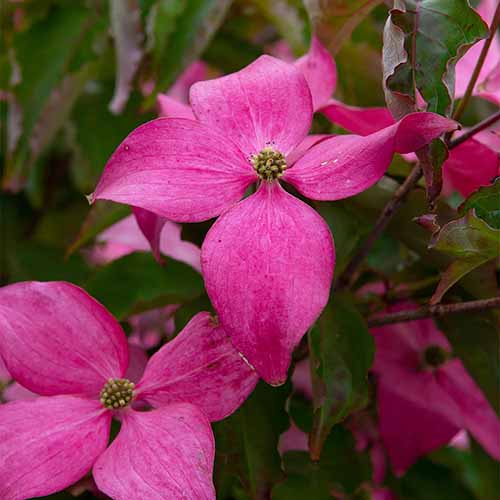
‘Scarlet Fire’ Kousa Dogwood
This is a kousa dogwood and it can also be found at Fast Growing Trees in a four to five foot height.
Our guide to growing flowering dogwood has more information.
15. Fern
You have a lot of options when it comes to ferns. There are at least 10,000 recorded species and a lot more that haven’t been identified yet.
There are hundreds that are common in gardens. Find one that grows in your Zone and has the shape you want and go to town. Ferns will provide interest underneath even the tallest camellia.
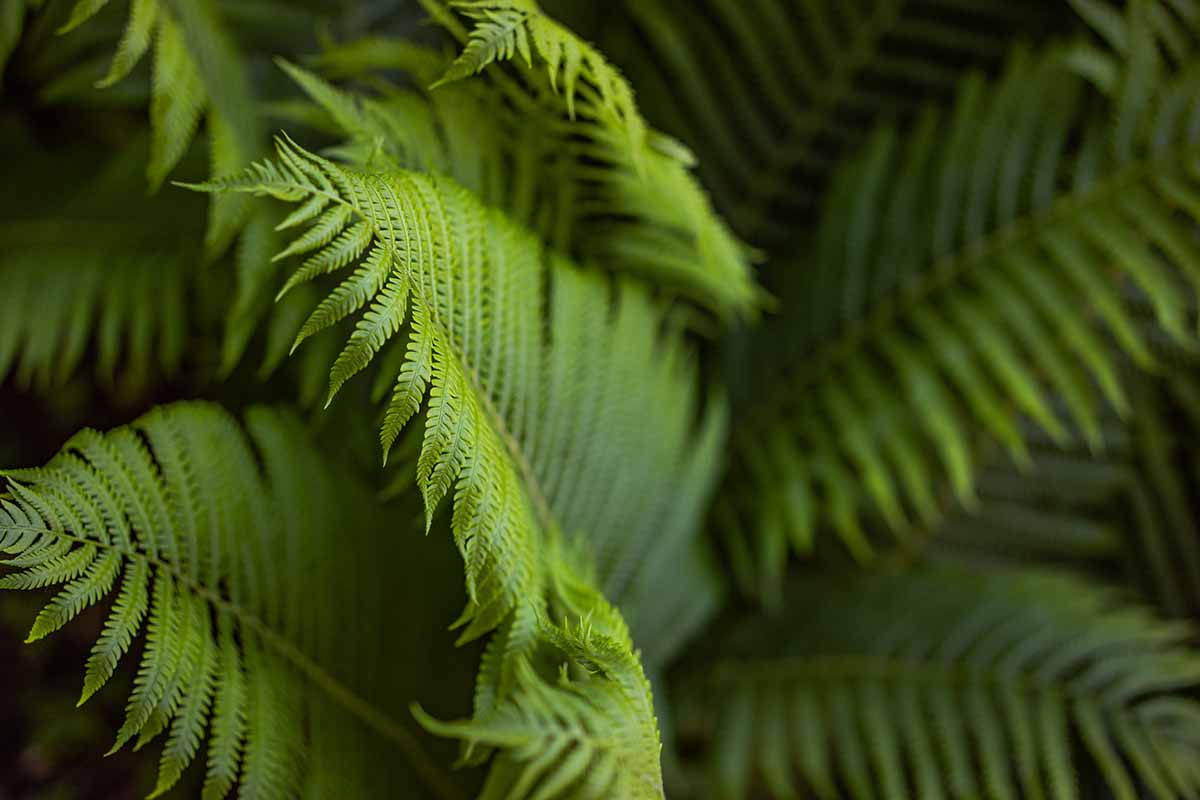
I personally have maidenhair ferns (Adiantum pedatum) and sword ferns (Polystichum munitum) under my camellias, but cinnamon (Osmundastrum cinnamomeum) or lady ferns (Athyrium filix-femina) would be awesome choices, as well.
Learn more about growing ferns in our guide.
16. Flowering Cherry
Ornamental cherries (Prunus spp.) are spring royalty. There are festivals, parades, and ceremonies all dedicated to the joy of the spring bloom.
Combine that with a camellia draped in a cloak of flowers and you’ll have a spectacular display. You’ll be looking forward to spring all year long.
Pick a small weeping type to grow in front of some tall camellia shrubs or go with something taller and place your shrubs nearby. Flowering cherries grow well in Zones 5 to 8.
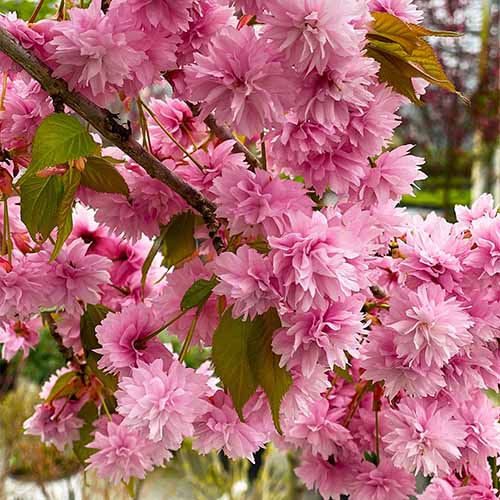
Weeping Extraordinaire™ Flowering Cherry
You can’t go wrong with any of the beautiful options out there, but Weeping Extraordinaire™aka ‘Extrazam’ is a showstopper. The fluffy, frilly pink blossoms are stunners.
Visit Fast Growing Trees for a four- to five- or five- to six-foot tree.
Learn all the ins and outs of growing flowering cherries in our complete guide.
17. Foamflower
I’m all for adding native species to our gardens when possible, and foamflower (Tiarella cordifolia) is native to eastern North America that dazzles with masses of pinkish-white blossoms that look like seafoam floating through your garden.
The plants reach one to two feet tall.
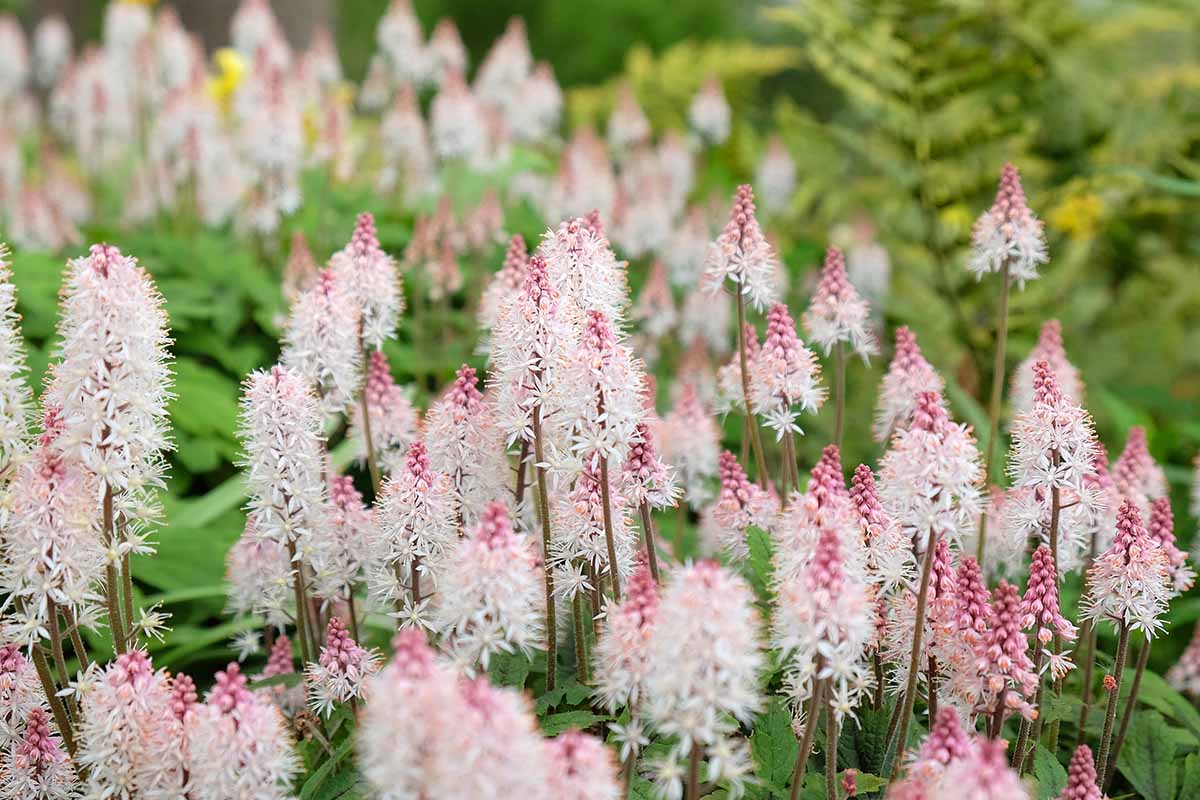
They bloom in the spring and are hardy in Zones 3 to 8, but what I like best is that they perform wonderfully in full shade.
That means you can fill in the empty space underneath your shrubs with something that will blossom when your camellias are wearing their green outfit.
18. Fuchsia
Whether you place a few hanging baskets near your camellia shrubs or plant some low-growers underneath, fuchsia (Fuchsia spp.) make a striking contrast to the green camellia leaves with their bright blossoms that last through spring, summer, and fall.



